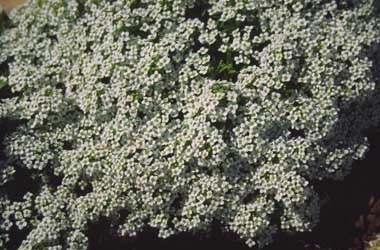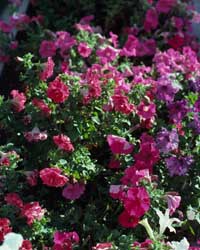Colourful Hanging Baskets
MASSED COLOUR BASKETS ARE IN VOGUE
 If the thought of hanging baskets brings back memories of macramé, woven cane and other folksy icons of the 70s, think again. Nowadays, the hanging baskets of Europe and North America are absolutely spectacular balls of colour. You might wonder how they achieve such stunning affects, until a closer look reveals that most are planted with a variety of different flowering plants.
If the thought of hanging baskets brings back memories of macramé, woven cane and other folksy icons of the 70s, think again. Nowadays, the hanging baskets of Europe and North America are absolutely spectacular balls of colour. You might wonder how they achieve such stunning affects, until a closer look reveals that most are planted with a variety of different flowering plants.
It’s best to think of hanging baskets as temporary features to be replanted each season. Even if the plants used are not annuals, it takes a bit of extra care to keep several different varieties growing vigorously for any length of time in the same confined root ball, hanging up, where they are exposed to drying winds and irregular watering. However over time the extra effort is worth it.
We can extend the life of a basket by:
- Using hardier and healthier plants. Plants such as ivy and succulents are excellent choices for hanging baskets because they tolerate difficult conditions.
- Using a top quality potting media with added water storing granules/crystals and wetting agent, and by lining baskets with a good layer of sphagnum moss to keep the media moist. It is critical that the media is kept moist – hanging baskets dry out quickly and need more water than pots on the ground.
- Auto irrigation/drip watering. This ensures the plants have a steady supply of moisture, unlike hand watering which can be irregular and inefficient.
- Regular feeding. Additional liquid feeds will help keep the plants in top condition.
- Protecting the plants from strong winds.
- Protecting them from too much shade or sun.
- Choosing plants of similar vigour, so that one doesn’t outgrow the others.
- Choosing pest and disease resistant plants. Not only will these plants be hardier, it means you don’t have the unpleasant task of taking the baskets down and using pesticides.
- Pinching out young tips to encourage branching and regularly removing spent flowers.
USE A HANGING MOSS BALL FOR DISPLAYING CUT FLOWERS
Put flowers straight into a ball of moist moss. Hang this ball of colour for an unusual, temporary display.
To make a moss ball, obtain two identical sized wire framed baskets remove the hanger supports; fill each half with moist moss (ideally use sphagnum moss) strap them together using wire of other suitable durable products.
Rehang and insert cut flowers directly into the moist moss ball.
The moss ball can be planted up with annuals and other flowering plants by filling the insides of each of sphagnum lined pot with potting mix before they are joined.
Another method is to make standard hanging baskets but include an empty vase during the 'construction' phase. When it as all planted up you can then add cut flowers to the vase, remembering to water the vase and plants in the hanging basket.
PLANT COMBINATIONS
There are two main ways you can choose hanging basket plant combinations:
1. Based on colour - using a single colour, or bright contrasting shades or complementary colours.
2. Based on cultural compatibility - by using plants which have similar requirements for water, sun, wind protection, etc.
Colour
 Colour combinations can be stunning, especially if you have several baskets with the same plantings hanging along the edge of a verandah. Plantings of single colours are simple and sophisticated, but think about how they will look against the house. Pink flowers probably wouldn’t work well against a red brick wall, nor would white flowers against a cream background.
Colour combinations can be stunning, especially if you have several baskets with the same plantings hanging along the edge of a verandah. Plantings of single colours are simple and sophisticated, but think about how they will look against the house. Pink flowers probably wouldn’t work well against a red brick wall, nor would white flowers against a cream background.
- White flowers: White lobelia, Impatiens (semi-pendulous types), Begonias, Vinca, Alyssum, Dianthus.
- Pink, mauve and white: Pink and white ‘Cascade’ petunias, Verbenas, Alyssum, Iberis (Candytuft), Lathyrus odoratus (Sweet pea), Mesembryanthemum (Livingstone Daisy), Erigeron (Seaside daisy), ornamental 'Sweet Pink' strawberry, Dianthus.
- Blue and white: White lobelia, Blue lobelia, Brachyscome, Star daisy (Chrysanthemum paludosum), Blue and white petunias, Heliotrope, Achimenes.
- Orange and yellow: Nasturtiums, Thunbergia alata (Black-eyed Susan), Marigolds, Coreopsis.
- Red: Flower Carpet Red roses, Petunias, Salvias, Columnea, Russelia, Impatiens.
- Multicolours (Some of these are available also in single colours): Portulaca, Petunias, Pansies, Violets, Gerberas, Geraniums, Pelargoniums, Portulaca, Zinnia, Dahlia, Torenia.
- Foliage colours: Coleus, Begonia, Gynura, Iresine, Ivy.
Cultural compatibility
Choosing plants with similar requirements can help to prolong the display. It makes it easier to look after the plants and to decide where to hang the basket, knowing that they all prefer the same growing conditions.
Good companions
- Geraniums, verbena, brachyscome (full sun, well drained media)
- Impatiens, lobelia, begonias (semi-shade or morning sun, moist media)
- Erigeron, gazania, salvia, petunia, dwarf 'Bambino' bougainvillea, ivy geraniums (for seabreezes)
HOW TO HANG A BASKET
Placement Of Baskets
· Select a spot out of prevailing winds, making sure that there is sufficient space around the basket to prevent knocking against things in strong winds.
· Position baskets so that they will not pose a safety risk to people passing by. They should ideally be placed at a good height for people to readily see the plants, but to the side of access areas so that they won’t be bumped into.
· Make sure the position obtains sufficient light for the plants’ requirements. The amount needed will depend on which plants you choose (eg. most ferns will cope well with low light conditions).
· You will also need to think about water dripping underneath the basket - what will it be dripping onto? Wet paved surfaces, for example, can be slippery so take care when you’re hanging the basket over a major access way.
Attaching Your Baskets
Making sure your baskets are securely hung is very important. You need to consider the weight of the basket when plants have grown significantly, when it has just been watered and additional strains on attachment such as the basket moving in the wind. Ideally use fittings that are rust proof, such as brass or galvanised ones.
Hooks can be screwed or bolted through overhanging rafters (such as under the roofline of verandahs).
Wall brackets can be securely attached to brick walls using anchor bolts or similar fasteners. Recent products on the market from garden centres allow hangers to be attached to brick walls without any bolts of screws.
The best way to find suitable fasteners is to visit your local hardware store, and look at the range of fasteners available. If you are still not sure which is the best method for you, then talk to staff at the store and ask for their advice.
Free standing hangers can be purchased as a way to avoid screwing bolts and fasteners into walls and rafters. These units are often enamelled-wire frames similar to bird cage supports.
Article by John Mason and staff of ACS Distance Education.
www.acs.edu.au
www.acsedu.co.uk
You may also be interested in....
Exceptional training for a serious business or career -lots of different options to specialize.
View Course